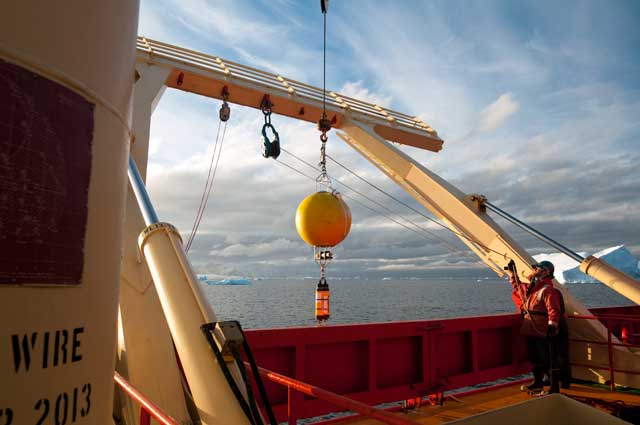|
Page 2/2 - Posted May 9, 2014
New project will deepen understanding of climate change effects on AntarcticaThis year’s recent fieldwork by the Palmer Long Term Ecological Research (LTER) The summer season was characterized by a massive krill recruitment event – “krill everywhere” – especially inshore near the Adélie colonies, according to Bill Fraser, another CONVERGE project co-PI from Polar Oceans Research Group who also leads the seabird component of the Palmer LTER. The birds remained mostly close to home, doing short foraging trips, Fraser said via e-mail. “As a result, we did not really see a marked tidal effect, suggesting in turn that when prey swamp the system, the birds become less dependent on tides to aggregate prey for them,” Fraser said. “This scenario would imply that the magnitude of the ‘tidal effect’ is itself controlled by a threshold of some sort in the abundance of krill.” Kohut, Bernard and collaborator Hank Statscewich Photo Credit: Peter Rejcek/Antarctic Photo Library
Engineers prepare an ocean glider for deployment near Palmer Station. A similar robot will be used for the CONVERGE project.
One of the key pieces of technology, which will be used for the first time in the Antarctic, is a CODAR high-frequency radar system The receiving antennas for the system need to be located at three locations. One site was easy: Palmer Station itself. The other two locations proved to be trickier to find, with the team finally settling on sites in the more remote Joubin and Wauwermans island chains. Those antennae will need remote power systems, primary wind and solar, to operate. The UAF team is developing the power stations. “From a technology standpoint, it’s pretty exciting in trying to figure out the logistics and different challenges in front of us in setting up this network, but once up and running, it will provide us the data we need to test our hypothesis,” Kohut said. “We need those maps of ocean currents so we can determine where the currents are concentrating and where they’re diverging.” The scientists will conduct their other observations in conjunction with the real-time map. Bernard will locate krill. A trio of underwater gliders will be deployed to search for phytoplankton. Fraser and his team with the Palmer LTER program will track the locations of the Adélie penguins, whose population in the region has remained stable since 2010 with between 2,300 and 2,500 breeding pairs. Learning more about the dynamics of the Palmer Deep and tidal influences on the food web may offer clues as to how the rest of the region may change as a more subantarctic climate pushes farther south. “Just through a better understanding of how the system is working, we can focus on one local mechanism that’s centered very much on this canyon, but we think the new understanding we gain from this work can be applied to the other hotspot canyon regions along the peninsula,” Kohut said. Added Fraser, “The main idea here would be that the evolution of penguin life history has been shaped at least in part by the long-term biophysical variability in ocean properties. The CONVERGE project will provide some clues as to what those properties might be (in fact, properties that have not been investigated before), hence possibly addimg another layer of information that we can then use to understand how life histories may be affected by climate-induced changes in the marine environment.” NSF-funded research in this article: Josh Kohut, Rutgers University, Award No. 1327248 |



For USAP Participants |
For The Public |
For Researchers and EducatorsContact UsU.S. National Science FoundationOffice of Polar Programs Geosciences Directorate 2415 Eisenhower Avenue, Suite W7100 Alexandria, VA 22314 Sign up for the NSF Office of Polar Programs newsletter and events. Feedback Form |


